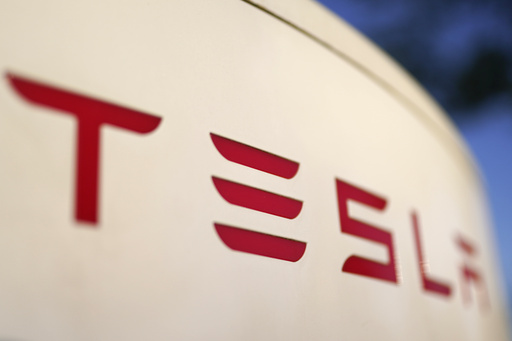Tesla 1Q profit falls 55%, but stock jumps as company moves to speed production of cheaper vehicles

FILE - The logo for the Tesla Supercharger station is seen in Buford, Ga, April 22, 2021. Faced with falling global sales and a tumbling stock price, Tesla has slashed prices again on some of its electric vehicles and its “Full Self Driving” system. Tesla releases first-quarter earnings Tuesday, April 23, 2024. (AP Photo/Chris Carlson, File)[ASSOCIATED PRESS/Chris Carlson]
Tesla’s first-quarter net income plummeted 55%, but its stock price surged in after-hours trading Tuesday as the company said it would accelerate production of new, more affordable vehicles.
The Austin, Texas, company said it made $1.13 billion from January through March compared with $2.51 billion in the same period a year ago.
Investors and analysts were looking for some sign that Tesla will take steps to stem its stock’s slide this year and grow sales. The company did that in a letter to investors Tuesday, saying that production of smaller, more affordable models will start ahead of previous guidance.
The smaller models, which apparently include the Model 2 small car that is expected to cost around $25,000, will use new generation vehicle underpinnings and some features of current models. The company said it would be built on the same manufacturing lines as its current products.
On a conference call with analysts, CEO Elon Musk said he expects production to start in the second half of next year “if not late this year.”
New factories or massive new production lines won’t be needed for the new vehicles, Musk said.
“This update may result in achieving less cost reduction than previously expected but enables us to prudently grow our vehicle volumes in a more capex efficient manner during uncertain times,” the investor letter said.
But Musk gave few specifics on just what the new vehicles will be and whether they would be variants of current models. “I think we’ve said all we will on that front,” he told an analyst.
He did say that he expects Tesla to sell more vehicles this year than last year’s 1.8 million.
The company also appears to be counting on a vehicle built to be a fully autonomous robotaxi as the catalyst for future earnings growth. Musk has said the robotaxi will be unveiled on Aug. 8.
Shares of Tesla rose 11% in trading after Tuesday’s closing bell, but they are down more than 40% this year. The S&P 500 index is up about 5% for the year.
Morningstar analyst Seth Goldstein said the company gave guidance about its future that was clearer than in the past, allaying investor concerns about production of the Model 2 and future growth. “I think for now we’re likely to see the stock stabilize,” he said. “I think Tesla provided an outlook today that can make investors feel more assured that management is righting the ship.”
But if sales fall again in the second quarter, the guidance will go out the window and concerns will return, he said.
Tesla reported that first-quarter revenue was $21.3 billion, down 9% from last year as worldwide sales dropped nearly 9% due to increased competition and slowing demand for electric vehicles.
Excluding one-time items such as stock-based compensation, Tesla made 45 cents per share, falling short of analyst estimates of 49 cents, according to FactSet.
The company’s gross profit margin, the percentage of revenue it gets to keep after expenses, fell once again to 17.4%. A year ago it was 19.3%, and it peaked at 29.1% in the first quarter of 2022.
Over the weekend, Tesla lopped $2,000 off the price of the Models Y, S and X in the U.S. and reportedly made cuts in other countries including China as global electric vehicle sales growth slowed. It also slashed the cost of “Full Self Driving” by one third to $8,000.
Tesla also announced last week that it would cut 10% of its 140,000 employees, and Chief Financial Officer Vaibhav Taneja said Tuesday the cuts will be across the board. Growth companies build up duplication that needs to be pruned like a tree to continue growing, he said.
Musk has been touting the robotaxi as a growth catalyst for Tesla since the hardware for it went on sale late in 2015.
In 2019, Musk promised a fleet of autonomous robotaxis by 2020 that would bring income to Tesla owners and make their car values appreciate. Instead, they’ve declined with price cuts, as the autonomous robotaxis have been delayed year after year while being tested by owners as the company gathers road data for its computers.
Neither Musk nor other Tesla executives on Tuesday’s call would specify when they expect Tesla vehicles to drive themselves as well as humans do. Instead, Musk touted the latest version of Tesla’s autonomous driving software — which the company misleadingly brands as “Full Self Driving” despite the fact that it still requires human supervision — and said that “it’s only a matter of time before we exceed the reliability of humans, and not much time at that.”
It didn’t take the Tesla CEO long to begin expounding on the possibility of turning on self-driving capabilities for millions of Tesla vehicles at once, although again without estimating when that might actually occur. He went on to insist that “if somebody doesn’t believe that Tesla is going to solve autonomy, I think they should not be an investor in the company.”
Early last year the National Highway Traffic Safety Administration made Tesla recall its “Full Self-Driving” system because it can misbehave around intersections and doesn’t always follow speed limits. Tesla’s less-sophisticated Autopilot system also was recalled to bolster its driver monitoring system.
Some experts don’t think any system that relies solely on cameras like Tesla’s can ever reach full autonomy.
___
Hamilton contributed to this report from San Francisco.
Copyright 2024 The Associated Press. All rights reserved. This material may not be published, broadcast, rewritten or redistributed without permission.